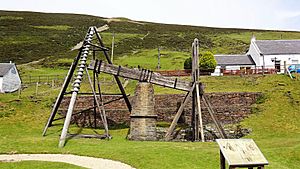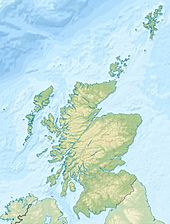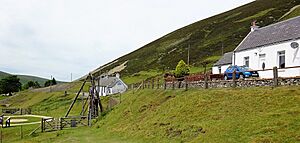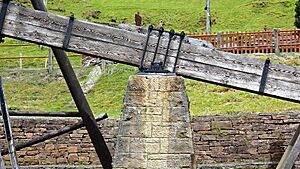Wanlockhead beam engine facts for kids
Quick facts for kids Wanlockhead beam engine |
|
|---|---|
| Straitside Lead Mine, Wanlockhead, Dumfries and Galloway, Scotland UK grid reference NS873125 |
|
 |
|
| Coordinates | 55°23′36″N 3°46′51″W / 55.393464°N 3.7808569°W |
| Type | A 19th century water pumping beam engine |
| Height | 13 ft. |
| Site information | |
| Owner | Historic Environment Scotland |
| Open to the public |
Yes |
| Condition | Restored as a stationary exhibit |
| Site history | |
| Built | 19th century |
| In use | 19th and 20th centuries |
| Materials | Stone, wood and iron |
The Wanlockhead beam engine is also known as the Wanlockhead water-bucket pumping-engine. You can find it near the Wanlock Water in the village of Wanlockhead, Scotland. This area is in the Lowther Hills, a part of the Southern Uplands.
This engine is very special because it's the only original water-powered beam engine left in the United Kingdom. It's still in its first location! The engine started working around 1870 and stopped about 1910.
It is now a protected site called a Scheduled Industrial Monument. This means it's considered very important to the country's history. The way it works was first inspired by ideas for a perpetual motion machine, which is a machine that could run forever without stopping.
Contents
History of the Engine
Water-powered pumping engines like this one have been around for a long time. Some were used as early as 1745. For example, one helped drain a coal mine in Canonbie in the 1790s.
Over time, steam-powered pumps started to replace them. A steam pump from the 1780s, once used at Earlston, is now kept at the National Museum of Scotland.
At the Straitsteps Mine, where our engine is, miners first used hand pumps between 1675 and 1684. These "rag-pumps" pulled water up using rags tied to a long rope. Later, water power was used. Two waterwheel-powered pumps, called "bab-gins," were installed at Straitsteps in 1710.
By 1779, a steam pumping engine from Boulton & Watt was used to drain the Straitsteps mine. This was later replaced by an even better Watt engine.
From 1870 to about 1910, the Wanlockhead beam engine helped drain water from the old parts of the Straitsteps lead mine. This mine had been worked since 1675. The engine also stopped the nearby Bay Lead Mine from flooding. Lead mining stopped in 1928, but lead and zinc were still taken from settling ponds until 1968.
How the Beam Engine Works
The main part of the engine is a long, horizontal wooden beam, about 8.5 meters (27 feet) long. This beam is made of strong pitch-pine wood. It swings up and down on a special pivot. This pivot has cast-iron blocks and brass bearings, which help it move smoothly. A strong iron axle holds it all together.
These parts are attached to a tall stone pillar, about 14 feet high. This pillar is built from carefully cut stone blocks. Metal rods pass through the stone column to hold everything firmly in place. The beam itself is made of two large pieces of wood joined by iron straps.
The stone column has a fancy carved top, looking a bit like an old railway bridge support. You can see small screws and smoothly turned brass parts, which show it was built in the late 1800s. Wedges and cotter pins are used to connect some parts.
Over the years, some of the wooden parts have been replaced. However, parts of the pumping rod might still be inside the old mine shaft. The wooden bucket that was on one end of the beam has rotted away. But the stone-lined pit, where the water used to go, is still there. A tall wooden tripod frame with a ladder stands nearby. This was used to work on the pump rod and to add or remove lead weights to balance the beam.
A large lead tank or cistern used to sit on the hill above the engine. Water from the Wanlock Burn flowed into this tank.
Another stone column from a beam engine is found at the Bay Mine. It's thought to be part of an engine built by William Symington. It's possible that the Straitsteps beam engine was used somewhere else before it came to Wanlockhead.
How the Engine Operated
Running this engine was very cheap because its "fuel" was free water! So, the biggest cost was just building it. Water flowed from the Wanlock Water into a lead tank above the engine. From there, it went under the road to a square bucket. This bucket was attached to the eastern end of the wooden beam.
The weight of the water in the bucket would pull that end of the beam down. This made the other end of the beam, which had a pumping rod, go up. This upward movement pulled water out of the mine using special flap valves. The engine could lift about 7,000 liters of water per hour! It would make two to three up-and-down movements per minute.
Once the bucket reached its lowest point, a valve would open, releasing the water back into the Wanlock Water. Then, the cycle would start again. This simple system was very reliable. It could run 24 hours a day with very little looking after.
You can see a working model of this water-bucket pumping-engine at the local lead mining museum.
Miners used to call the engine "Bobbin John" because of its nodding, up-and-down movement.
In front of the beam engine, you can see a double circle shape on the ground. This shows where a horse gin once stood. This was used to pull miners and ore out of the mine before the beam engine was built.
Straitsteps and the Miners' Cottages
Some of the original single-story miners' cottages are still used today. Others are kept safe by the Museum of Scottish Lead Mining. For example, the East and West Straitsteps Cottages stand just above the beam engine. The name 'Straitsteps' refers to a part of the galena (lead ore) vein that runs through the area.





